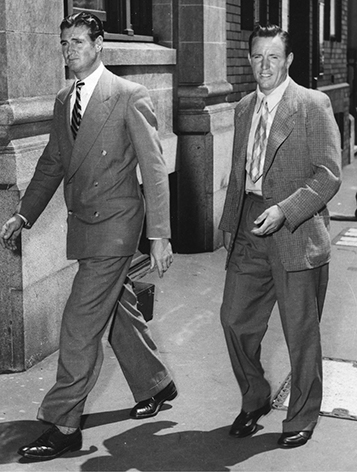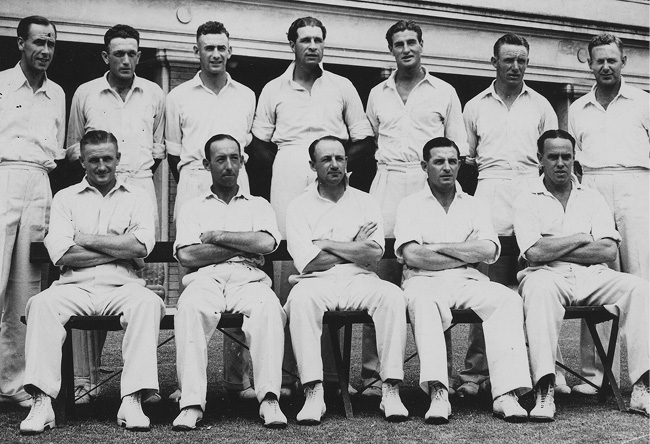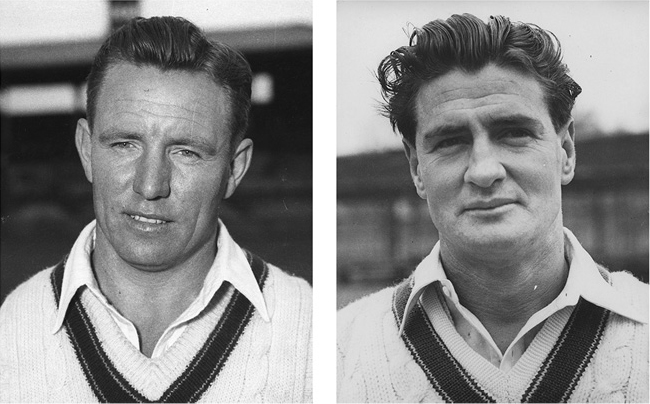
Debonair: Ray Lindwall (right) with his fast-bowler partner Keith Miller at the height of their fame in the early 1950s. They opened the Australian bowling in six Ashes campaigns.
H
‘Give us Keith Miller and we’ll beat the world…’
HUNTING IN PAIRS
The greatest fast bowlers have always hunted in pairs. Few were more explosive, or as enduring, as Australia’s post-war dynamos Ray Lindwall and Keith Miller, responsible for more than 40 per cent of Australia’s wickets in the first decade of post-war Test cricket.
With his graceful, accelerating run-up, classic side-on action and signature outswing, Lindwall was the Rolls-Royce of fast bowlers and for a decade and more the most admired and threatening expressman in the world. No two Lindwall balls in a row were ever alike, and with his low action, his bouncer would skid straight at the throat. Handsome, charismatic Miller, the game’s Errol Flynn, was a three-in-one cricketer, bowling devilishly fast, batting in the top four or five and taking astonishing reflex catches in the slips as if he was nonchalantly rolling a cigarette. Had the war not delayed his debut until his late 20s, his record would have been even more impressive.
The pair were central in Australia’s remarkable run of success in the first decade after the war, smashing through top-orders from Birmingham to Brisbane, and with ‘Big Bill’ Johnston, the multi-gifted Victorian, were a formidable fast-bowling trinity on the 1948 tour when Australia remained unbeaten over five months and 34 matches.
Despite disparate backgrounds and differing cities of origin – one was from Sydney, the other from Melbourne – they were the closest of mates, hooking up originally in New Zealand in 1946 and became inseparable, rooming together, sharing beers and banter like two long-lost brothers.
One of their habits each night on tour was to empty out their pockets and leave their change in a mounting heap on the dressing table, Lindwall, a staunch Catholic, taking it to the church on Sundays. Miller would prefer to snooze in but would always say as Lindwall was leaving: ‘Say a few Hail Marys for me, too, Jack [his nickname for Lindwall].’
Together they took almost 400 Test wickets, Lindwall being the first Australian fast bowler to a double-century. Stockier and broader of chest, Lindwall was consistently faster than his mate and hooped the ball away from the right-handers at near express speed. His captains, from Don Bradman to Richie Benaud, always gave him the choice of ends. In sweltering summer heat in Melbourne one day, Victoria’s one-Test opener George Thoms had the temerity to question Lindwall’s pace and was immediately subjected to the two fastest overs of his life. In South Africa in 1949–50, Lindwall threatened to flatten captain Lindsay Hassett when told he was being dropped from the fifth Test team. He had a fast bowler’s temper.
Miller, taller, bouncier and more unpredictable, was just as lethal and even more volatile. Working into the wind gave him more scope for his in-swinger and he could still a pin a batsman onto his back foot with a throat-high bouncer. Once he did it to Don Bradman in his Sydney testimonial. It was no coincidence that within weeks he’d been sensationally omitted from Australia’s next tour. He blamed Bradman for his failure to be appointed Australia’s captain and died still harbouring grudges against the Don, who he believed played the game too ruthlessly.
He had no such reservations about pace partner Lindwall, believing him to be in a class of his own, on and off the field.
‘No one could touch Ray,’ he told me. ‘He was a great man, a church-goer, and it was a privilege to play with him. As a fast bowler there was daylight between him and the rest. He’d bowl his first ball as fast as his last. One morning at Lord’s [in 1953], he yorked Tom Graveney first-ball and Tom was in good touch, too. He’d told me in the rooms that morning: “Let’s limber up here, Nug. Get into him flat out straight away. He looks a bit sluggish when he starts.” And before most of the members had had a chance to even take their seats, he went straight through him. It was a cracker. That set Ray apart from every other fast bowler. He thought about what he was doing and always bowled it exactly where he wanted.’

Partners in Pace: Keith Miller and Ray Lindwall took eight wickets against England in a high scoring draw in Adelaide in 1946–47. The team was: back row, left to right: Fred Freer (12th man), Don Tallon, Bruce Dooland, Ernie Toshack, Keith Miller, Ray Lindwall, Arthur Morris. Front: Colin McCool, Lindsay Hassett, Don Bradman (captain), Merv Harvey, Ian Johnson.
Lindwall’s extraordinary burst of six for 20 in the final Test at The Oval in 1948 saw England bowled out in two and a half hours for just 52. A decade earlier at the same ground it had batted into a third day and made 7–903 declared!
Lindwall and Miller captured 40 wickets for the series, Lindwall a career-best 27 and Miller 13, a lingering back injury from his war years not allowing him to bowl as often as he and Bradman wanted.
The Don carried the scars of Australia’s 1938 drubbing at The Oval into his farewell tour in 1948 and, looking for revenge, wanted Lindwall and Miller to bowl short and intimidate the English top-order at every opportunity. A new ball was allowed every 55 overs that summer and rarely were Lindwall, Miller or Johnston required to bowl with anything that wasn’t shiny or near new.
Having played their debut Test together, an eight-hour affair against the New Zealanders in Wellington in autumn, 1946, the Lindwall-Miller combine had shifted into top gear against Wally Hammond’s visiting Englishmen with the resumption of Ashes cricket at the Gabba in 1946–47. In a sensational start to his Ashes career, Miller took seven for 60 and two for 17 to go with his 79 from No. 5. He even knocked the cap of tough-as-teak Lancastrian Cyril Washbrook from his head. Lindwall was ill and able to bowl just 12 overs for the game. Returning in mid-summer he took three wickets in Melbourne, six in Adelaide and nine in Sydney.
The following summer, Miller was having a drink with his mate after a tough day of leather-chasing in Adelaide when told by an administrator Bill Jeanes to ‘finish up’ as he had taxis waiting downstairs. The heat was sweltering, and the champion Indian Vijay Hazare had made a second century in the match of his life. He kept whipping Miller through square leg and Miller had asked Bradman for reinforcement, but was told ‘no’. Miller finished his over with two off-breaks and was immediately taken off.

Post-War Destroyers: Few top-orders could repel the duel menace of Ray Lindwall (left) and Keith Miller.
|
RAY LINDWALL and KEITH MILLER’S BEST TESTS TOGETHER |
|
Fifth Test v West Indies, 1951–52: Fourteen wickets (for 155) – Lindwall 2–20 and 5–52, Miller 5–26 and 2–57 |
|
Fourth Test v England, Leeds, 1953: Fourteen wickets (for 260) – Lindwall 5–54 and 3–104, Miller 2–39 and 4–63 |
Given the 35-degree heat, Jeanes was as frazzled as the two fast bowlers and sharp words were exchanged. Bradman was notified. He asked Miller to see him at his stockbroking office the following day. Miller felt like an errant schoolboy being summoned into the Head’s study. In Melbourne he’d grabbed a souvenir stump at the match-end only to again be admonished. Administrators felt him intolerably extrovert. Miller knew he was lucky to be alive and like Arthur Morris and others who had seen active duty during the seven dark years of war, it felt surreal to be playing cricket again. He didn’t like Bradman treating it like a war.
During the 1948 tour, Miller took exception when Bradman asked him to pepper fellow serviceman Bill Edrich with bumpers. Edrich was a family man who Miller liked. All England was on rations after the War. Almost everyone was doing it hard. Not for the first time, he tossed the ball back to Bradman, suggesting someone else do his ‘dirty work’.
Throughout his career Miller bowled less often than most frontliners, Lindwall averaging 20 per cent more overs. Fifty-one of Miller’s 55 Tests were alongside Lindwall. In the four matches he played without his mate, he shouldered more responsibility, including at Lord’s in 1956 when he took the only 10-wicket match haul of his career.
The pair remained Australia’s first choice opening pair through six Ashes series in a row, their spirited duels with England’s champion Len Hutton always a highlight. Twice they took 14 wickets in Tests and three times shared 40 wickets for the series. The showdown for world supremacy against the West Indies in 1951–52 was a fizzer after Lindwall and Miller worked over the Windies’ three batting stars – Everton Weekes, Frank Worrell and Clyde Walcott – with the greatest bumper assault seen since Bodyline. Having shocked England with a 3–1 victory in 1950, the Windies were beaten 4–1, Lindwall taking 21 wickets and Miller 20. The peppering began in Brisbane, Miller being warned after bowling three bouncers before finishing the over with a slow off-break. ‘Any objections to that?’ he asked the umpire.
In 1955 in the Caribbean, the locals howled with excitement when Lindwall and Miller unleashed their bumpers, one even penning a ditty to Lindwall: ‘Bowl Lindwall,’ he said. ‘Don’t be ’fraid, if da can’t bat, break der shoulder blade.’
With his war record, charisma and matinee-idol looks, Miller was hero-worshipped everywhere he went. He was the ultimate sports hero for tens of thousands of Australians, young and old, male and female in the 1950s. If the Australian team visited a country centre, captain Lindsay Hassett would always invite Miller on stage with him as part of the welcome.
‘Never before,’ Miller would invariably begin, ‘have I ever seen such a motley mob of men… or… such a beautiful array of gorgeous gals!’
During a wartime services match in India, a swarm of insects surrounded Miller, Hassett immediately quipping: ‘Must be female!’
Miller was 27 and Lindwall 25 when Ashes cricket resumed after the war. While Lindwall was a comparative unknown, Miller already had a profile in England, having been based in London throughout much of the war. Representing the Dominions at Lord’s in 1943, he came on to bowl at second change. Denis Compton was on strike and turning to the wicketkeeper Stan Sismey, asked, ‘What does this chap do?’
‘He doesn’t really bowl,’ replied Sismey. ‘Just turns his arm over. Probably just wants a bit of exercise. But he can be a bit quick.’ Miller was quick all right, the fastest Compton had faced since Ernie McCormick in 1938.
|
RAY LINDWALL and KEITH MILLER IN TEST CRICKET |
|||||
|
|
|
Ray Lindwall |
Keith Miller |
||
|
Season |
Opponent |
Wickets |
Average |
Wickets |
Average |
|
1945–46 |
New Zealand (a) |
2 |
14.50 |
2 |
3.00 |
|
1946–47 |
England (h) |
18 |
20.38 |
16 |
20.87 |
|
1947–48 |
India (h) |
18 |
16.89 |
9 |
24.78 |
|
1948 |
England (a) |
27 |
19.62 |
13 |
23.15 |
|
1949–50 |
South Africa (a) |
12 |
20.66 |
17 |
22.94 |
|
1950–51 |
England (h) |
15 |
22.93 |
17 |
17.70 |
|
1951–52 |
West Indies (h) |
21 |
23.05 |
20 |
19.90 |
|
1952–53 |
South Africa (h) |
19 |
20.16 |
13 |
18.54 |
|
1953 |
England (a) |
26 |
18.84 |
10 |
30.30 |
|
1954–55 |
England (h) |
14 |
27.21 |
10 |
24.30 |
|
1955 |
West Indies (a) |
20 |
31.85 |
20 |
32.05 |
|
1956 |
England (a) |
7 |
34.00 |
21 |
22.23 |
|
1956–57 |
Pakistan (a) |
1 |
64.00 |
2 |
29.00 |
|
1956–57 |
India (a) |
12 |
16.58 |
– |
– |
|
1958–59 |
England (h) |
7 |
29.85 |
– |
– |
|
1959–60 |
Pakistan (a) |
3 |
40.67 |
– |
– |
|
1959–60 |
India (a) |
6 |
37.00 |
– |
– |
|
Totals |
|
228 |
23.03 |
170 |
22.97 |
In 1945 at Lord’s, he made 185 for the Dominions, his greatest ever innings. When he wasn’t playing cricket, he’d be charming the members at Ascot in top hat and tails. He was the classiest of all wild colonial boys.
Even into his mid-30s Miller had the ability to swing matches. Bowling unchanged before lunch in the Melbourne Test of 1954–55, Miller took three for 8 in one of the great opening spells. Later that memorable summer, in Adelaide when England was set just 94 to win the Ashes, a supercharged Miller dismissed captain Hutton, Edrich and Colin Cowdrey in 20 balls and took a low-down, disputed catch on the offside to dismiss Peter May, at which a despairing Hutton exclaimed, ‘the boogers have doon us!’ England was to win by five wickets but it had been an inspired effort from Miller, whose best was always extraordinary.
‘Give us Keith Miller,’ West Indian captain John Goddard once said, ‘and we’ll beat the world.’